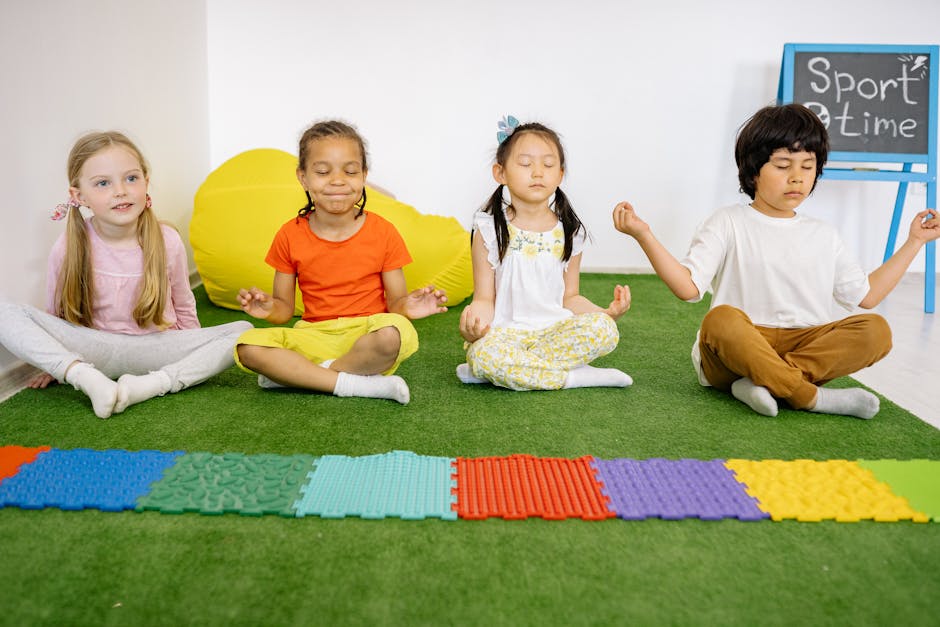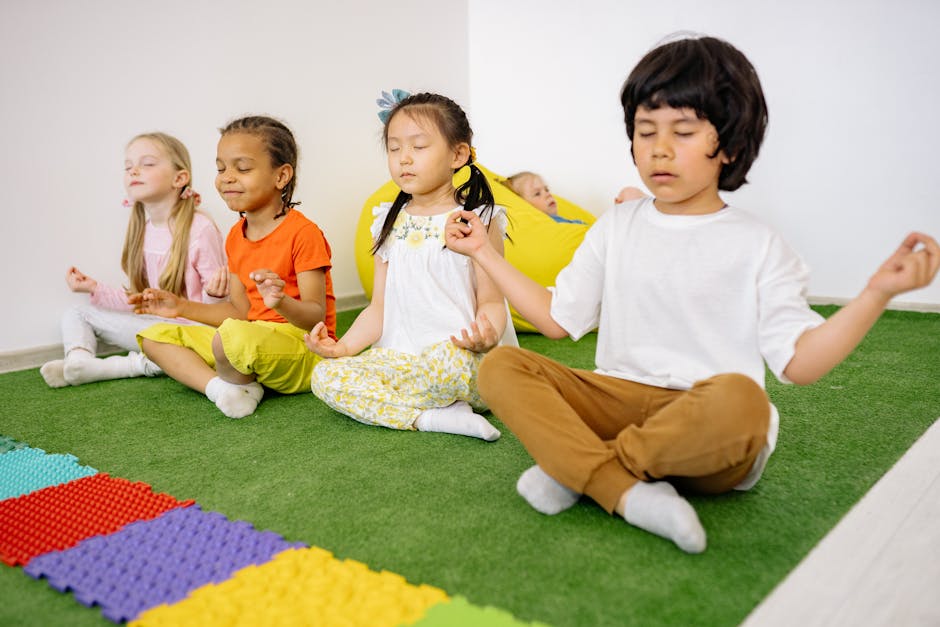Cultivating joy through mindful play is like discovering a hidden treasure chest of happiness within your daily life.
Imagine a world where every moment is filled with laughter, creativity, and a sense of wonder.
This is what mindful play offers, and it’s something everyone can experience.
Keep reading to uncover how you can bring more joy into your life through the art of play.
Key Takeaways
- Mindful play combines mindfulness and play to enhance joy.
- It involves being present, engaging the senses, and balancing activity with rest.
- Techniques include playful meditation, creative expression, and nature-based play.
- Building a community around mindful play can amplify its benefits.
- Personal stories highlight the transformative power of mindful play.
Introduction to Mindful Play
Definition of Mindful Play
Mindful play is the practice of engaging in activities with full awareness and presence.
It’s about immersing yourself in the moment, letting go of distractions, and embracing the joy of play.
Whether it’s through art, movement, or simply being in nature, mindful play encourages you to connect deeply with your surroundings.
Importance of Joy in Daily Life
Joy is like sunshine for the soul.
It brightens your day, lifts your spirits, and makes life more enjoyable.
Incorporating joy into your daily routine can improve your mental health, boost your creativity, and enhance your overall well-being.
Mindful play is a powerful tool for cultivating this joy.
Connection Between Mindfulness and Play
Mindfulness and play are like two peas in a pod.
When combined, they create a magical experience that allows you to be fully present and engaged.
Mindfulness helps you focus on the here and now, while play adds an element of fun and spontaneity.
Together, they form a dynamic duo that can transform your life.

Principles of Mindful Play
Presence and Awareness
Being Fully Engaged in the Moment
To truly enjoy mindful play, you must be fully present.
This means putting away your phone, letting go of worries, and focusing on the activity at hand.
Whether you’re painting, dancing, or playing a game, immerse yourself completely and savor each moment.
Observing Without Judgment
Mindful play encourages you to observe your thoughts and feelings without judgment.
It’s about accepting yourself and your experiences as they are, without trying to change them.
This non-judgmental awareness allows you to enjoy play without the pressure of perfection.
Embodied Experience
Engaging the Senses
Engaging your senses is a key aspect of mindful play.
Feel the texture of the paintbrush, listen to the rhythm of the music, or smell the fresh air during a nature walk.
By tuning into your senses, you can deepen your connection to the present moment and enhance your enjoyment of play.
Physical Movement and Play
Physical movement is an essential component of mindful play.
Whether it’s through yoga, dance, or sports, moving your body helps release tension and boosts your mood.
It’s a fun and effective way to cultivate joy and mindfulness simultaneously.
Stillness and Reflection
Balancing Activity with Rest
While play is important, so is rest.
Balancing activity with moments of stillness and reflection allows you to recharge and gain new insights.
Take time to pause, breathe, and reflect on your experiences.
This balance is crucial for maintaining a joyful and mindful life.
Finding Peace in Quiet Moments
In the hustle and bustle of daily life, finding peace in quiet moments can be a challenge.
However, these moments of stillness are essential for cultivating joy through mindful play.
Whether it’s through meditation, journaling, or simply sitting in silence, embrace these moments of peace and let them nourish your soul.

Techniques to Cultivate Joy Through Play
Playful Meditation Practices
Guided Imagery and Visualization
Guided imagery and visualization are powerful tools for mindful play.
Close your eyes and imagine a peaceful scene, like a beach or a forest.
Allow yourself to explore this imaginary world, noticing the sights, sounds, and sensations.
This practice can help you relax and tap into your inner joy.
Breathing Exercises with Playful Elements
Breathing exercises are a cornerstone of mindfulness, and adding playful elements can make them even more enjoyable.
Try breathing in rhythm with a favorite song or imagining your breath as a gentle wave.
These playful techniques can help you stay present and cultivate joy.
Creative Expression
Art and Craft Activities
Art and craft activities are a fantastic way to express yourself and engage in mindful play.
Whether it’s painting, drawing, or crafting, let your creativity flow without worrying about the outcome.
The process of creating is where the magic happens.
Music and Dance as Play
Music and dance are universal languages of joy.
Put on your favorite tunes and let your body move freely.
Dance like nobody’s watching and feel the rhythm of the music.
This form of mindful play can uplift your spirits and bring a smile to your face.
Nature-Based Play
Outdoor Exploration
Nature is a playground waiting to be explored.
Take a walk in the park, hike a trail, or simply sit under a tree.
Engage with the natural world and let it inspire your mindful play.
The sights, sounds, and smells of nature can awaken your senses and fill you with joy.
Gardening and Interaction with Nature
Gardening is a wonderful way to connect with nature and practice mindful play.
Planting seeds, tending to plants, and watching them grow can be a meditative and joyful experience.
It’s a reminder of the beauty and wonder of the natural world.

Building a Community of Mindful Play
Creating Safe Spaces for Play
Spiritual Sanctuaries and Retreats
Creating safe spaces for mindful play is essential for fostering joy and connection.
Spiritual sanctuaries and retreats offer a supportive environment where you can explore play without judgment.
These spaces encourage self-discovery and personal growth.
Community Gatherings and Workshops
Community gatherings and workshops are great opportunities to connect with others who share your passion for mindful play.
These events provide a platform for sharing experiences, learning new techniques, and building a supportive network.
Collaborative Play Activities
Group Games and Exercises
Group games and exercises are a fun way to engage in mindful play with others.
Whether it’s a team sport, a group meditation, or a collaborative art project, playing together can strengthen bonds and amplify joy.
Sharing Experiences and Stories
Sharing experiences and stories is a powerful way to connect with others and deepen your understanding of mindful play.
Listen to others’ stories, share your own, and learn from each other’s journeys.
This exchange of ideas and experiences can inspire and uplift you.

Personal Stories and Inspirations
Transformative Experiences Through Play
Personal Journey of Healing and Joy
Many people have experienced profound healing and joy through mindful play.
For some, it’s been a journey of self-discovery and transformation.
These personal stories highlight the power of play to heal and inspire.
Stories from Others Who Embrace Mindful Play
Hearing stories from others who embrace mindful play can be incredibly inspiring.
These stories offer insights into the diverse ways people incorporate play into their lives and the joy it brings them.
Lessons Learned from Mindful Play
Overcoming Challenges
Mindful play is not without its challenges.
However, overcoming these challenges can lead to valuable lessons and personal growth.
Embrace the obstacles as opportunities to learn and evolve.
Insights and Growth
Through mindful play, you can gain insights into yourself and the world around you.
These insights can lead to personal growth and a deeper understanding of what brings you joy.
Conclusion
Recap of Key Points
Mindful play is a powerful practice that combines mindfulness and play to cultivate joy.
By being present, engaging your senses, and balancing activity with rest, you can enhance your enjoyment of life.
Encouragement to Incorporate Mindful Play
Incorporating mindful play into your daily routine can transform your life.
It’s a simple yet effective way to bring more joy, creativity, and connection into your world.
Invitation to Explore Further Opportunities for Joy and Growth
The journey of mindful play is ongoing and full of possibilities.
Explore new activities, connect with others, and continue to discover the joy that mindful play can bring.
For more ideas on how to bring joy into your life, check out activities that bring joy and creative hobbies.
Happy playing!
Discover the Joy: FAQ on Cultivating Happiness Through Mindful Play
What is mindful play and how does it differ from regular play?
Mindful play involves engaging in activities with full presence and awareness, focusing on the experience rather than the outcome. Unlike regular play, which may be more spontaneous or goal-oriented, mindful play emphasizes being in the moment and appreciating the sensations, emotions, and interactions that arise during the activity.
How can mindful play contribute to cultivating joy?
Mindful play cultivates joy by allowing individuals to fully immerse themselves in the present moment, reducing stress and enhancing emotional well-being. By focusing on the here and now, people can experience a sense of freedom and creativity, which often leads to feelings of happiness and fulfillment.
What are some examples of mindful play activities?
Examples of mindful play activities include yoga, painting, playing a musical instrument, or even engaging in a simple game with friends or family. The key is to approach these activities with an open mind and a focus on the process rather than the result.
Can adults benefit from mindful play, or is it just for children?
Adults can greatly benefit from mindful play as it provides an opportunity to break away from routine and stress. Engaging in playful activities with mindfulness can enhance creativity, improve mental health, and foster a sense of joy and relaxation, making it beneficial for individuals of all ages.
How can I incorporate mindful play into my daily routine?
Incorporating mindful play into your daily routine can be as simple as setting aside a few minutes each day to engage in an activity you enjoy, with full attention and presence. It could be drawing, dancing, or even mindful walking. The goal is to be fully present and enjoy the experience without distractions.
What role does mindfulness play in enhancing the joy derived from play?
Mindfulness enhances the joy derived from play by encouraging individuals to focus on the present moment, which can lead to a deeper appreciation of the activity. This focus helps reduce anxiety about the past or future, allowing for a more joyful and fulfilling experience.
Are there any scientific benefits associated with mindful play?
Yes, scientific studies have shown that mindful play can reduce stress, improve emotional regulation, and enhance overall well-being. Engaging in mindful activities can also boost cognitive function and creativity, contributing to a healthier, more balanced lifestyle.
How can parents encourage mindful play in their children?
Parents can encourage mindful play by setting aside time for unstructured, creative activities and participating in them with their children. Encouraging children to focus on the sensations and emotions they experience during play can help them develop mindfulness skills that contribute to their emotional and mental well-being.
What are some challenges people might face when trying to practice mindful play?
Some challenges include distractions from technology, difficulty in focusing, and the tendency to prioritize productivity over leisure. Overcoming these challenges requires setting boundaries, creating a conducive environment for play, and practicing patience and self-compassion.
Can mindful play be practiced in a group setting, and how does it differ from solo play?
Mindful play can certainly be practiced in a group setting, where participants focus on the shared experience and interactions. Group mindful play can enhance social connections and foster a sense of community, while solo play allows for personal reflection and self-discovery. Both forms offer unique benefits and can be enjoyed interchangeably.



